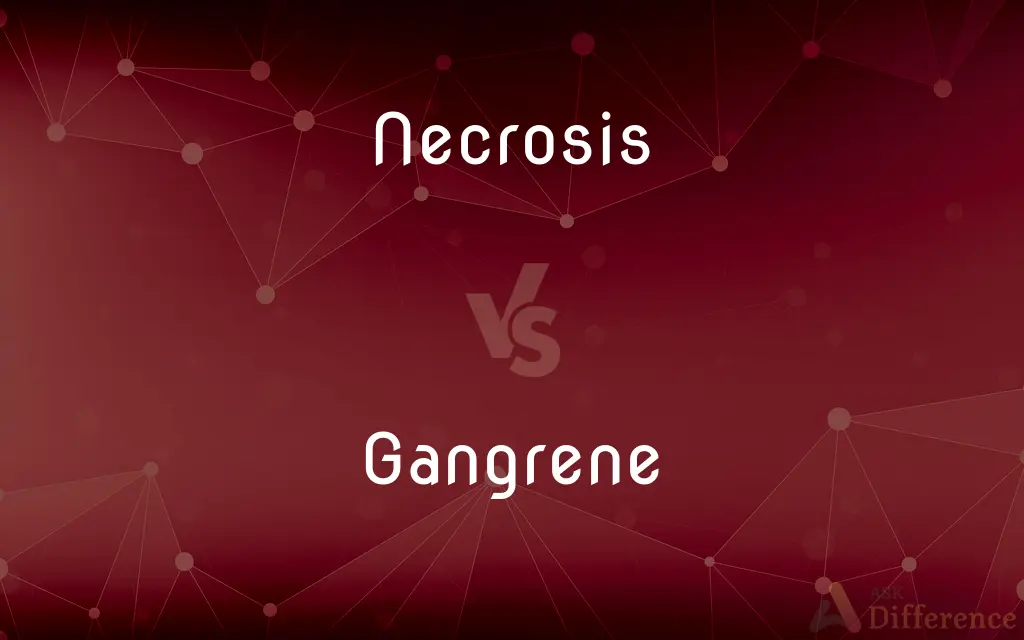Necrosis vs. Gangrene — What's the Difference?
By Tayyaba Rehman — Updated on October 30, 2023
Necrosis refers to the premature death of cells in living tissue, while Gangrene is the decay of body tissue due to interrupted blood flow, often associated with bacterial infection.

Difference Between Necrosis and Gangrene
Table of Contents
ADVERTISEMENT
Key Differences
Necrosis is a broader term that defines the untimely death of cells within a living tissue, often due to factors like toxins, infection, or trauma. Gangrene, on the other hand, is a specific type of tissue death that arises primarily because of insufficient blood supply.
While Necrosis can occur in any tissue of the body, Gangrene typically affects extremities such as fingers, toes, and limbs.
A significant distinction between Necrosis and Gangrene is that Gangrene can be accompanied by a bacterial infection, leading to the decaying smell often associated with it.
Both Necrosis and Gangrene are severe conditions, but while Necrosis can be a part of various pathologies, Gangrene is always a serious concern that often requires surgical intervention.
Comparison Chart
Definition
Death of cells in living tissue.
Decay of tissue due to lack of blood flow.
ADVERTISEMENT
Causes
Toxins, infection, trauma, etc.
Interrupted blood flow, often with bacterial infection.
Affected Areas
Any tissue in the body.
Typically extremities: fingers, toes, limbs.
Association with Infection
Can occur without bacterial infection.
Often associated with bacterial infection.
Treatment Requirement
Can vary depending on cause and severity.
Often requires surgical intervention.
Compare with Definitions
Necrosis
Necrosis can be triggered by factors such as trauma or infection.
After the venomous bite, the area showed signs of Necrosis.
Gangrene
Gangrene typically affects the extremities like fingers and toes.
The severe infection led to Gangrene in her foot.
Necrosis
Necrosis can occur in various tissues throughout the body.
The lack of oxygen during the stroke led to Necrosis in brain cells.
Gangrene
Gangrene is a serious medical condition requiring urgent attention.
If Gangrene is not treated promptly, amputation might be necessary.
Necrosis
Necrosis is often visible as discolored or damaged tissue.
The area around the wound turned black, indicating Necrosis.
Gangrene
Bacterial infection often accompanies Gangrene.
The decaying smell indicated a severe case of Gangrene.
Necrosis
Necrosis is the premature death of cells in living tissue.
The burn caused Necrosis in the surrounding skin cells.
Gangrene
Dry and wet are common types of Gangrene, based on appearance and cause.
The wound's wet appearance suggested the onset of wet Gangrene.
Necrosis
The progression of Necrosis can lead to tissue destruction.
Left untreated, the Necrosis spread, damaging more tissues.
Gangrene
Gangrene is the decay of body tissue due to lack of blood flow.
He developed Gangrene in his toe after the frostbite.
Necrosis
Necrosis (from Ancient Greek νέκρωσις, nékrōsis, "death") is a form of cell injury which results in the premature death of cells in living tissue by autolysis. Necrosis is caused by factors external to the cell or tissue, such as infection, or trauma which result in the unregulated digestion of cell components.
Gangrene
Gangrene is a type of tissue death caused by a lack of blood supply. Symptoms may include a change in skin color to red or black, numbness, swelling, pain, skin breakdown, and coolness.
Necrosis
Death of cells through injury or disease, especially in a localized area of a tissue or organ.
Gangrene
Death and decay of body tissue, often in a limb or digit, caused by insufficient blood supply to the affected area as a result of injury, infection, or disease, and commonly classified as wet (when bacterial infection is involved) or dry (when infection is not a significant factor).
Necrosis
(pathology) The localized death of cells or tissues through injury, disease, or the interruption of blood supply.
Gangrene
To affect or become affected with gangrene.
Necrosis
The pathologic death of part of a tissue due to irreversible damage. Contrast to necrobiosis, which is a normal death of cells in a tissue. Formerly, applied primarily to death of bone tissue.
Gangrene
The necrosis or rotting of flesh, usually caused by lack of blood supply.
If gangrene sets in, we may have to amputate the foot.
Necrosis
A disease of trees, in which the branches gradually dry up from the bark to the center.
Gangrene
(figuratively) A damaging or corrupting influence.
Necrosis
The localized death of living cells (as from infection or the interruption of blood supply)
Gangrene
(transitive) To produce gangrene in.
Gangrene
(intransitive) To be affected with gangrene.
Gangrene
(transitive) To corrupt; To cause to become degenerate.
Gangrene
A term formerly restricted to mortification of the soft tissues which has not advanced so far as to produce complete loss of vitality; but now applied to mortification of the soft parts in any stage.
Gangrene
To produce gangrene in; to be affected with gangrene.
Gangrene
Necrotic tissue; a mortified or gangrenous part or mass
Gangrene
The localized death of living cells (as from infection or the interruption of blood supply)
Gangrene
Undergo necrosis;
The tissue around the wound necrosed
Common Curiosities
Can Necrosis lead to Gangrene?
Yes, untreated Necrosis, especially with compromised blood flow, can progress to Gangrene.
How is Gangrene treated in severe cases?
Severe Gangrene often requires surgical intervention, including potential amputation of the affected area.
Is Necrosis always visible?
No, while Necrosis can result in visible tissue damage, it might occur internally without immediate visible signs.
Can Gangrene spread to other parts of the body?
Yes, if left untreated, Gangrene can spread, and the bacteria causing it can enter the bloodstream.
What are common causes of Necrosis?
Trauma, toxins, infections, and certain medications can lead to Necrosis.
Are there different types of Necrosis?
Yes, types include coagulative, liquefactive, caseous, fat, and fibrinoid Necrosis, based on appearance and underlying causes.
How does Gangrene typically present itself?
Gangrene presents as decaying body tissue, especially in extremities, often due to interrupted blood flow and bacterial infection.
Is Gangrene contagious?
Gangrene itself isn't contagious, but the bacteria causing the infection can spread to others in some cases.
What is Necrosis in medical terms?
Necrosis refers to the premature death of cells in living tissue, often due to factors like toxins or trauma.
How is Necrosis diagnosed?
Necrosis is diagnosed based on physical examination, tissue biopsies, and imaging studies.
How can Gangrene be prevented?
Ensuring good blood circulation, prompt treatment of wounds, and managing underlying health conditions can help prevent Gangrene.
Can Gangrene occur without an evident injury?
Yes, underlying conditions like diabetes or arteriosclerosis can lead to Gangrene without a noticeable injury.
Is Necrosis reversible?
Once cells have undergone Necrosis, they can't be revived, but preventing further progression is possible.
Share Your Discovery

Previous Comparison
Bill vs. Rapier
Next Comparison
Scoop vs. TeaspoonAuthor Spotlight
Written by
Tayyaba RehmanTayyaba Rehman is a distinguished writer, currently serving as a primary contributor to askdifference.com. As a researcher in semantics and etymology, Tayyaba's passion for the complexity of languages and their distinctions has found a perfect home on the platform. Tayyaba delves into the intricacies of language, distinguishing between commonly confused words and phrases, thereby providing clarity for readers worldwide.















































